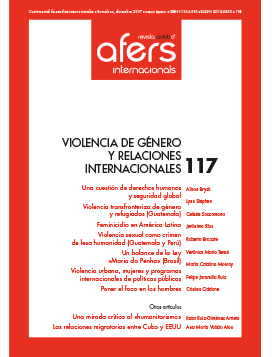Violencia transfronteriza de género y mujeres indígenas refugiadas de Guatemala
Palabras clave:
Guatemala, migración, indígenas, violencia de género, guerra civil, marasResumen
Revista CIDOB d’Afers Internacionals, nº 117
Cuatrimestral (octubre-diciembre 2017)
ISSN:1133-6595 | E-ISSN:2013-035X
DOI: https://doi.org/10.24241/rcai.2017.117.3.29
Este artículo examina la violencia de género estructural que sufren las mujeres y las niñas indígenas refugiadas de Guatemala. Para ello, se emplea un marco analítico interseccional transfronterizo y se utilizan las declaraciones incluidas en las solicitudes de asilo y las entrevistas realizadas a 24 mujeres y niñas indígenas, complementadas con 60 entrevistas a jueces, activistas, abogados y defensores que trabajan en y para los tribunales guatemaltecos especializados en violencia de género. La política económica integrada de Estados Unidos, México y América Central, así como las políticas militares, comerciales y de inmigración de la región, son el marco más amplio en el que ha evolucionado la violencia de género y son parte integrante de las vidas de las mujeres y las niñas indígenas que huyen hoy de Guatemala.
Citas
Abrego, Leisy. Sacrificing Families: Navigating Laws, Labor, and Love Across Borders. Stanford: Stanford University Press, 2014.
ACAN-EFE. «Organización humanitaria denuncia aumento feminicidios en Guatemala en 2015». La Noticia en Guatemala (9 de febrero de 2015) (en línea) [Fecha de consulta: 29.10.2017] http://lanoticiaenguatemala.com/organizacion-humanitaria-denuncia-aumento-feminicidios-en-guatemalaen-2015/
American Immigration Council. Fact Sheet: Asylum in the United States. AIC, (22 de agosto de 2016) (en línea) [Fecha de consulta: 04.06.2017] https://www.americanimmigrationcouncil.org/research/asylum-united-states
Bevan, Anna Claire. «Feminicide: Guatemala’s Growing Epidemic». New Internationalist (22 de agosto de 2011) (en línea) [Fecha de consulta: 29.10.2017] http://newint.org/blog/majority/2011/08/22/guatemala-femicide-murder-womens-rights/
Burrell, Jennifer. Maya After War: Conflict, Power, and Politics in Guatemala. Austin: University of Texas Press, 2013.
Byrne, Huge; Stanley, William y Garst, Rachel. Rescuing Police Reform: A Challenge for the New Guatemala Government. Washington D.C.: Washington Office on Latin America (WOLA), 2000.
Carey, David y Torres, Gabriela. «Precursors to Femicide: Guatemalan Women in a Vortex of Violence». Latin American Research Review, vol. 45, n.º 3 (2010), p. 142-164.
Carpena-Méndez, Fina. Growing up across Trenches, Letters and Borders: An Ethnography of Childhood, Youth, and the Everyday in Neo-Liberal Rural Mexico. Tesis de doctorado, Universidad de California en Berkeley, 2006.
CENADOJ-Centro Nacional de Análisis y Documentación Judicial. «Ley contra el Femicidio y otras Formas de Violencia Contra la Mujer. Decreto Número 22-2008». CENADOJ, ciudad de Guatemala (2 de mayo de 2008) (en línea) https://www.oas.org/dil/esp/Ley_contra_el_Femicidio_y_otras_Formas_de_Violencia_Contra_la_Mujer_Guatemala.pdf
CEH-Comisión para el Esclarecimiento Histórico. Guatemala, Memoria de Silencio. Informe de la Comisión para el Esclarecimiento Histórico. Ciudad de Guatemala: CEH-UNOPS, 1999.
Crenshaw, Kimberlé. «Mapping the margins: Intersectionality, identity politics, and violence against women of color», en Crenshaw, Kimberlé; Gotanda, Neil; Peller, Gary y Thomas, Kendall (eds.). Critical race theory. Nueva York: The New Press, 1995, p. 357-383.
CVR-Comisión de la Verdad y Reconciliación. Informe Final de la Comisión de la Verdad y Reconciliación. CVR (27 y 28 de agosto de 2003) (en línea) http://www.cverdad.org.pe/ifinal/
De Pablo, Ofelia; Zurita, Javier y Tremlett. Giles. «Guatemalan war rape survivors: ‘We have no voice». The Guardian (28 de julio de 2011) (en línea) http://www.theguardian.com/lifeandstyle/2011/jul/28/guatemalan-women-mass-rape-giveevidence/
Foster, Cindy. «Violent and Violated Women: Justice and Gender in Rural Guatemala, 1936-1956». Journal of Women’s History, vol. 11, n.º 3 (1999), p. 55-77.
Glebbeek, Mary Louise. «Police Reform and the Peace Process in Guatemala: The Fifth Promotion of the National Civilian Police». Bulletin of Latin American Research, vol. 20, n.º 4 (2001), p. 431-453.
Goodwin Gill, Guy S. «Convention Relating to the Status of Refugees, Geneva, 28 July 1951 and Protocol Relating to the Status of Refugees, New York, 31 January 1967». Audiovisual Library Of International Law (2008) (en línea) http://legal.un.org/avl/ha/prsr/prsr.html
Green, Linda Fear as a Way of Life: Mayan Widows in Rural Guatemala. Nueva York: Columbia University Press, 1999.
INE-Instituto Nacional de Estadística. Caracterización República de Guatemala. Ciudad de Guatemala: Instituto Nacional de Estadística, 2014 (en línea) [Fecha de consulta: 29.10.2017] https://www.ine.gob.gt/sistema/uploads/2014/02/26/L5pNHMXzxy5FFWmk9NHCrK9x7E5Qqvvy.pdf
IWGIA-International Working Group for Indigenous Affairs. The Indigenous World 2016. Copenhagen: IWGIA, 2016a (en línea) [Fecha de consulta: 29.10.2017] https://www.iwgia.org/images/publications//0740_THE_INDIGENOUS_ORLD_2016_final_eb.pdf
IWGIA-International Working Group for Indigenous Affairs. Los Pueblos Indígenas de Guatemala. Copenhagen: IWGIA, 2016b (en línea) [Fecha de consulta: 29.10.2017] https://www.iwgia.org/es/guatemala
Kennedy, Elizabeth No Childhood Here: Why Central American Children are Fleeing their Homes. Washington D.C.: American Immigration Council, 2014 (en línea) https://www.americanimmigrationcouncil.org/sites/default/files/research/no_childhood_here_why_central_american_children_are_fleeing_their_homes.pdf
Leiby, Michelle. «Wartime Sexual violence in Guatemala and Peru». International Studies Quarterly, vol. 53, n.º 2 (2009), p. 445-468.
Levenson, Deborah T. Adiós Niño: The Gangs of Guatemala City and the Politics of Death. Durham y Londres: Duke University Press, 2013.
Lugones, María. «Indigenous Movements and decolonial feminism». Seminario de grado y posgrado, Department of Women’s, Gender and Sexuality Studies, The Ohio State University (21 de marzo de 2014) (en línea) https://wgss.osu.edu/sites/wgss.osu.edu/files/LugonesSeminarReadings.pdf
Martínez, Óscar. The Beast: Riding the Rails and Dodging Narcos on the Migrant Trail. Londres y Nueva York: Verso, 2014.
Menjívar, Cecilia. «Violence and Women’s Lives in Eastern Guatemala: A Conceptual Framework». Latin American Research Review, vol. 43, n.º 3 (2008), p. 109-136.
Menjívar, Cecilia. Enduring Violence: Ladina Women’s Lives in Guatemala. Berkeley: University of California Press, 2011.
Sanford, Victoria. Buried Secrets: Truth and Human Rights in Guatemala. Nueva York: Palgrave MacMillan, 2003.
Sanford, Victoria. «From Genocide to Femicide: Impunity and Human Rights in Twenty-First Century Guatemala». Journal of Human Rights, vol. 7, n.º 2 (2008), p. 104-122.
Sharp, Ellen Jane. 2014. Vigilante: Violence and Security in Postwar Guatemala. Tesis de doctorado en antropología, Universidad de California en Los Angeles (en línea) http://escholarship.org/uc/item/0p78b6vf
UNDP-United Nations Development Programme. Human Development Report 2014. Sustaining Human Progress: Reducing Vulnerabilities and Building Resilience. Guatemala. Nueva York: UNDP, 2014 (en línea) http://hdr.undp.org/sites/default/files/hdr14-report-en-1.pdf
Vogt, Wendy. «Crossing Mexico: Structural violence and the commodification of undocumented Central American migrants». American Ethnologist, vol. 40, n.º 4 (2013), p. 764-780.
Yarris, Kristin. «“Pensando Mucho” (“Thinking too Much”): Embodied Distress among Grandmothers in Nicaraguan Transnational Families». Culture, Medicine & Psychiatry , vol. 38, n.º 3 (2014), p. 473-498.
Yarris, Kristin. Care Across Generations: Solidarity and Sacrifice in Transnational Families. Palo Alto: Stanford University Press, 2017.












